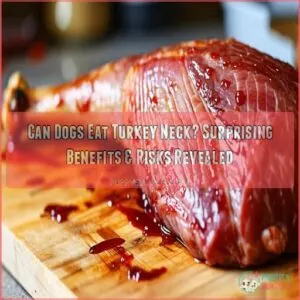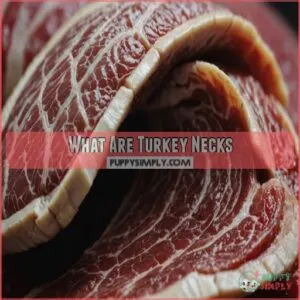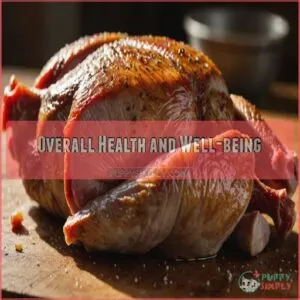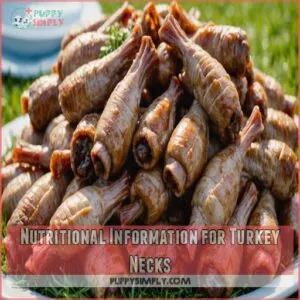This site is supported by our readers. We may earn a commission, at no cost to you, if you purchase through links.
 Yes, dogs can eat turkey neck, but there’s more to the story than a simple "bon appétit."
Yes, dogs can eat turkey neck, but there’s more to the story than a simple "bon appétit."
When prepared safely and cooked thoroughly, turkey necks offer a protein-packed treat for your canine companion.
They’re like nature’s toothbrush, promoting dental health as your pup gnaws away.
However, just like ham with its high sodium content and potential to cause dehydration, sodium sensitivity, and kidney damage can be detrimental to canine health. Raw turkey necks can harbor harmful bacteria like salmonella, potentially turning your dog’s digestive system into a gastrointestinal battlefield.
Moderation is key, as with any treat.
Before you start serving up turkey necks like they’re going out of style, consider factors like your dog’s size, health, and dietary needs.
There’s a whole world of nutritional benefits and potential risks to explore.
Table Of Contents
- Key Takeaways
- What Are Turkey Necks
- Benefits of Turkey Necks for Dogs
- Nutritional Information for Turkey Necks
- Frequently Asked Questions (FAQs)
- Can dogs eat raw turkey necks safely?
- Can dogs eat frozen turkey necks?
- Are turkey necks beneficial for dogs?
- Can dogs eat turkey necks on Thanksgiving?
- What happens if a dog eats a turkey neck?
- Can dogs eat turkey neck bones?
- Can dogs eat cooked turkey neck?
- Can dogs get salmonella from raw turkey neck?
- Is turkey neck safe to eat?
- Can dogs eat neck bone meat?
- How often can I feed my dog turkey necks?
- Can turkey necks replace regular meals for dogs?
- Are there alternatives to turkey necks for small dogs?
- How should I store and handle raw turkey necks?
- Can puppies safely eat turkey necks?
- Conclusion
Key Takeaways
Here are 4 key takeaways about whether dogs can eat turkey neck:
- Turkey necks can be a nutritious treat for dogs, offering dental benefits, joint support, and mental stimulation when given properly.
- You should only feed your dog raw or dehydrated turkey necks, never cooked ones, as cooked bones can splinter and cause harm.
- There are risks to consider, including choking hazards and potential bacterial contamination, so always supervise your dog and consult your vet first.
- Feed turkey necks in moderation, about 1-2 times a week, as a treat rather than a meal replacement, and choose appropriately sized necks for your dog.
What Are Turkey Necks
You’ve likely seen turkey necks in your local butcher shop or pet store, but did you know they’re more than just leftover poultry parts?
Turkey necks are the entire neck of the turkey, sans head and skin, containing spine, muscle, and connective tissue that can offer surprising benefits for your canine companion.
Definition and Composition
What’s all the fuss about turkey necks for dogs? They’re not just leftover poultry parts; they’re a meaty, bony treasure trove of canine nutrition. Turkey necks consist of the entire neck minus the head, skin, and crop.
They’re packed with:
- Spine and bone structure for calcium
- Muscle content for protein
- Connective tissue for joint health
- Cartilage for glucosamine
- Trachea for added crunch
These raw poultry bones make excellent dog chews, offering a natural treat that’s both nutritious and entertaining for your furry friend.
Provenance and Sourcing
Now that you know what turkey necks are, let’s talk turkey about where they come from.
You’ll want to sniff out free-range farms with ethical sourcing practices.
When considering turkey necks as a treat for your dog, it’s essential to choose a source that minimizes the risk of bacterial contamination from raw turkey necks. These farms are more likely to provide raw turkey necks that are safe for your pup.
Look for suppliers who are transparent about their farm practices and traceability.
This way, you’re barking up the right tree when it comes to minimizing risks of bacterial contamination, including Salmonella.
Your dog’s safety is the top dog here!
Preparation and Storage
Regarding turkey necks, just like with other treats such as candy with high sugar content, proper preparation and storage are key to keeping your furry friend safe and satisfied.
You can find a variety of products related to turkey neck dog on online marketplaces like Turkey Neck Dog.
Here’s your go-to guide for handling these tasty treats:
- Dehydration: Air-dry turkey necks slowly to preserve nutrients and texture
Benefits of Turkey Necks for Dogs
You’ll be surprised by the multitude of benefits turkey necks offer your canine companion.
From promoting dental health to supporting joint function, these nutrient-rich treats can contribute greatly to your dog’s overall well-being and happiness.
Dental Health and Hygiene
Turkey necks aren’t just tasty treats; they’re natural toothbrushes for your furry friend.
As your dog gnaws on these chewy delights, they’re giving their teeth a thorough cleaning.
The abrasive action scrubs away plaque and tartar, promoting better gum health and fresher breath.
It’s like hitting the doggy dentist without the hefty bill!
| Dental Benefit | How It Works | Impact on Your Dog |
|---|---|---|
| Plaque Removal | Mechanical scraping | Reduces tooth decay |
| Gum Stimulation | Increased blood flow | Healthier gums |
| Breath Freshening | Bacteria reduction | Goodbye, doggy breath! |
Joint Health and Mobility
As your dog gnaws away on a turkey neck, they’re not just keeping their teeth clean.
These natural chews pack a powerful punch for joint health and mobility.
Here’s how turkey necks can keep your furry friend springing like a pup:
- Rich in glucosamine and chondroitin
- Natural source of collagen
- Helps manage arthritis pain
These components work together to lubricate joints, rebuild cartilage, and reduce inflammation.
It’s like giving your dog’s joints a spa day with every chew!
Mental Enrichment and Stimulation
Imagine your furry friend’s eyes lighting up as they tackle a chewy challenge.
Turkey necks aren’t just treats; they’re mental gymnastics for your dog’s brain.
Chewing satisfies their natural instincts, keeping boredom at bay and even helping to relieve stress.
It’s like a 20-minute puzzle that engages their senses and keeps them focused.
Plus, the satisfaction of conquering a turkey neck boosts their confidence and overall well-being.
Nutritional Value and Content
Beyond keeping your pup’s mind sharp, turkey necks pack a powerful nutritional punch.
These tasty treats are a goldmine of health benefits:
- High protein content for muscle maintenance
- Dense bones rich in calcium and phosphorus
- Loaded with glucosamine and chondroitin for joint health
You’re not just giving your dog a chew toy; you’re serving up a nutritional powerhouse.
The mineral profile of turkey necks supports overall bone health, while their natural composition aids in dental hygiene.
Overall Health and Well-being
Turkey necks pack a powerful punch for your pup’s overall health.
They’re a treasure trove of nutrients that boost immune function, support digestive health, and promote a glossy coat.
The high-quality protein aids muscle development, while the natural chewing action keeps teeth clean and minds engaged.
You can even find a variety of dog chew turkey options online, providing a safe and convenient way to give your dog this healthy treat.
Plus, the variety in your dog’s diet can lead to increased energy levels and improved joint health.
It’s like a doggy multivitamin in a tasty, natural package!
Nutritional Information for Turkey Necks
To truly appreciate turkey necks for dogs, let’s dig into their nutritional powerhouse.
These tasty treats are packed with protein, essential for muscle maintenance and overall health.
They’re also rich in vitamins, particularly B12, which supports your pup’s nervous system and energy levels.
In terms of minerals, turkey necks are a goldmine.
They’re loaded with calcium and phosphorus, key for maintaining strong bones and teeth.
You can find raw turkey necks at local grocery stores or farmers markets, or purchase dehydrated ones online from reputable sources, like a trusted source for dehydrated turkey necks.
The high bone density in turkey necks contributes to dental health, acting like nature’s toothbrush.
Don’t forget about the fat content – it’s moderate and provides a good energy source.
Plus, the natural collagen in turkey necks supports joint health and mobility, making them a smart choice for aging dogs.
Whether you choose raw or dehydrated poultry bones, you’re giving your furry friend a nutrient-dense snack that’s both delicious and beneficial.
Frequently Asked Questions (FAQs)
Can dogs eat raw turkey necks safely?
Dogs need to chew on tough foods like chewing on pigs feet to help their teeth and gums. Did you know that 90% of a dog’s dental health relies on proper chewing?
Raw turkey necks can be safe for dogs, but they’re not without risks.
You’ll need to supervise closely and consider your dog’s size and chewing habits.
Can dogs eat frozen turkey necks?
Yes, you can feed your dog frozen turkey necks.
They’re great for slowing down enthusiastic eaters and providing a cool treat.
Just remember to supervise closely and make sure the size is appropriate for your pup’s chompers.
Are turkey necks beneficial for dogs?
Like a nutritious treasure trove, turkey necks offer dogs a bounty of benefits.
They’re packed with protein, essential vitamins, and joint-supporting nutrients.
Chewing them helps clean teeth and provides mental stimulation.
However, always supervise and consider your dog’s size and health.
Can dogs eat turkey necks on Thanksgiving?
While turkey necks can be a tasty treat for dogs, they’re not ideal for Thanksgiving.
You’ll want to avoid sharing cooked bones, which can splinter.
Instead, offer a safe, raw turkey neck under supervision.
What happens if a dog eats a turkey neck?
Chewing bliss or digestive distress? Your dog’s turkey neck feast can be a double-edged sword.
They’ll get protein and dental benefits, but risks include choking, constipation, or bacterial infection.
Always supervise and consult your vet before serving this treat.
Can dogs eat turkey neck bones?
Dogs can eat raw or dehydrated turkey neck bones, but there are risks associated with choking hazards and bacterial contamination, as explained in raw turkey neck benefits, but there are risks.
They’re great for dental health and joint support, but can cause choking or digestive issues.
Always supervise and choose appropriate sizes for your pup’s safety.
Can dogs eat cooked turkey neck?
Although you might think it’s safer, cooked turkey necks can pose a choking hazard and cause intestinal damage due to their tendency to splinter into sharp shards. Cooked turkey necks are a no-go for dogs.
They can splinter, causing serious harm.
Stick to raw or dehydrated options instead.
Always supervise and consult your vet before introducing new treats.
Can dogs get salmonella from raw turkey neck?
Yes, your dog can get salmonella from raw turkey necks.
These treats carry a risk of bacterial contamination, including salmonella.
To keep your pup safe, consider alternatives like dental chews or supervised raw feeding practices.
Is turkey neck safe to eat?
With 70% of dog owners considering turkey necks as treats, it’s important to understand their safety.
Raw or dehydrated turkey necks can be safe for most dogs, but they’re not without risks.
Always supervise and consult your vet first.
Can dogs eat neck bone meat?
Dogs can safely enjoy neck bone meat, but there are risks to keep in mind.
It’s rich in nutrients and can help clean teeth, but always supervise your pup.
Chewing bones can be a choking hazard, so choose appropriately sized ones.
How often can I feed my dog turkey necks?
Feeding your dog turkey necks should be done in moderation.
You can offer them as a treat 1-2 times a week, depending on your dog’s size and overall diet.
Always supervise and consult your vet for personalized advice.
Can turkey necks replace regular meals for dogs?
Turkey necks shouldn’t replace regular meals for your dog.
They’re treats, not a balanced diet.
You’ll want to stick to proper dog food for main meals.
Think of turkey necks as the cherry on top, not the whole sundae!
Are there alternatives to turkey necks for small dogs?
Did you know that 40% of dog owners prefer smaller chews?
For your pint-sized pup, try chicken necks, dental chews, or bully sticks.
These alternatives offer similar benefits to turkey necks but in more manageable sizes.
Always supervise your dog’s chewing time.
How should I store and handle raw turkey necks?
Keep raw turkey necks in the freezer until you’re ready to use them.
Thaw in the fridge, not at room temperature.
Handle with clean hands and utensils, and wash surfaces afterward.
Serve immediately or refrigerate for up to two days.
Can puppies safely eat turkey necks?
Ye olde" wisdom suggests caution.
Puppies shouldn’t eat turkey necks due to choking risks and digestive systems that aren’t fully developed.
You’re better off sticking to puppy-specific treats and foods until they’re older and their jaws are stronger.
Conclusion
Like a double-edged sword, turkey necks offer both benefits and risks for your canine companion.
While they can promote dental health and provide nutritional value, it’s important to weigh these advantages against potential hazards.
Can dogs eat turkey neck? Yes, but with caution.
Always consult your veterinarian before introducing new treats, and remember that moderation is key.
By making informed decisions about your dog’s diet, you’ll make sure they reap the rewards of turkey necks without compromising their well-being.













